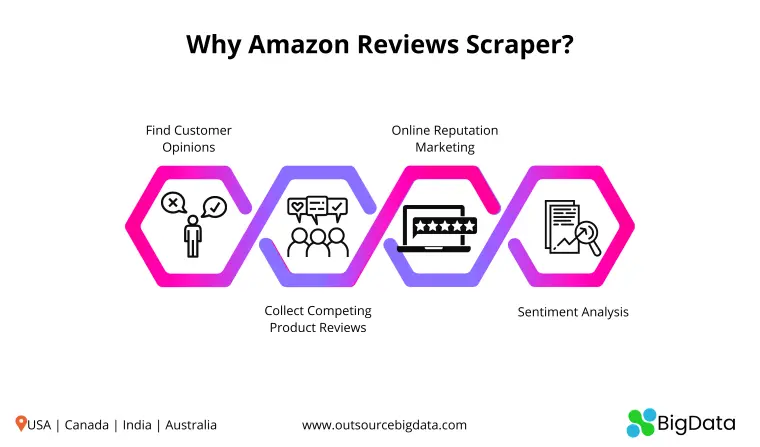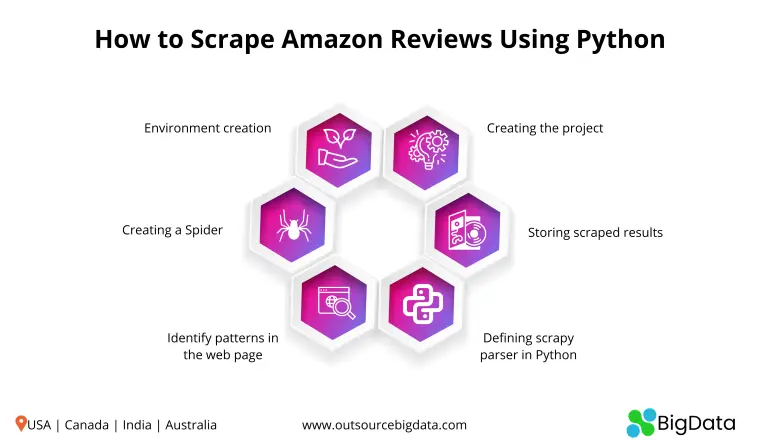Checklist to Build Amazon
Reviews Scraper
Author : Jyothish
Author : Jyothish
AIMLEAP Automation Works Startups | Digital | Innovation | Transformation

Table of Contents
A. Why Amazon reviews scraper?
- Find Customer Opinions
- Collect Competing Product Reviews
- Online Reputation Marketing
- Sentiment Analysis
B. Checklist to build Amazon reviews scraper
C. Essentials of building an Amazon reviews scraper
D. Amazon web scraping tools
E. Challenges to scrape Amazon reviews
F. How to scrape Amazon reviews using Python
- Environment creation
- Creating the project
- Creating a Spider
- Identify patterns in the target web page
- Defining Scrapy parser in Python
- Storing scraped results
G. Using an Amazon reviews scraper for agility and automation
To begin with, Amazon is one of the largest online marketplaces in the world. The platform contains vast data vital for online businesses. Whether product descriptions or reviews, using a web scraping tool you can access high-quality Amazon data automatically and use that data to yield valuable insights. Scraping tools are built to extract and organize the data from specific websites within a short span of time. The latest fiscal numbers from Amazon (2021) show that the company made $125.6 billion in sales revenue in the fourth quarter of 2020. The popularity of Amazon extends to the fact that
Almost 90 % of consumers are more likely to purchase a product from Amazon than any other website.
A major factor driving these sales is the availability of extensive reviews on Amazon. In fact, 73% of consumers say that positive customer reviews make them trust an eCommerce website better. The product review data on Amazon has several other potential advantages. Small-scale and mid-scale businesses are fast emerging, with sales of more than 4,000 items per minute in the US alone. These upcoming businesses often look to harness these advantages by using an Amazon reviews scraper. Such a scraper extracts product review information from Amazon and saves them onto the desired output file.
According to Bright Local Survey, 78% of customers trust product reviews available on Amazon.
In fact, nearly 9 out of every 10 (89%) of customers make the effort to read a product’s reviews before actually going ahead with the purchase. This reflects the scope of impact that review information potentially holds. Emerging businesses often do not have access to review information as vast as that available on Amazon. For this reason, making use of Amazon web scraping tools to extract review data from Amazon is a highly useful option for such businesses.
Why Amazon reviews scraper?
The authenticity and huge range of Amazon reviews make a scraper an ideal and effective means to analyze various trends and market situations in-depth. This is the reason why businesses and sellers would use an Amazon reviews scraper to target the products in their inventory. They can use the tool to scrape Amazon reviews from product pages and save them onto the desired format. In fact, doing so proves beneficial to businesses in multiple ways.

1. Find Customer Opinions
Amazon dealers can scrape Amazon reviews to recognize factors that influence a product’s ranking. In this manner, they can establish successful strategies to boost these rankings further. Therefore, by using the review data obtained from Amazon web scraping tools, Amazon sellers can improve their products and customer service.
2. Collect Competing Product Reviews
Businesses can scrape Amazon review data to better understand aspects of products with positive or negative impacts. In this manner, an Amazon reviews scraper helps to learn about what appeals to the customers better, allowing a business to better capture the market and make smart decisions.
3. Online Reputation Marketing
Large-scale companies often have a broad product inventory, and it is hard to individually keep track of how well products are performing. However, they can use Amazon web scraping tools to extract information about a specific product. This data would work as input to different analysis tools that measure the consumer’s sentiment towards that particular product.
4. Sentiment Analysis
The data collected with an Amazon reviews scraper helps in identifying the consumers’ emotions towards a particular product. Therefore, Amazon web scraping tools help prospective buyers understand the general sentiment and perspective towards the product before actually purchasing it. In addition, sellers can scrape Amazon reviews to gather information about how well the product is performing in terms of customer satisfaction.
Checklist to build Amazon reviews scraper
There are essential and core steps involved that need to be undertaken for the extraction of product review data efficiently. Albeit the basic coding done in Python, there are other important steps as well when executing a Python Amazon review scraper. By successfully implementing these steps in the checklist, it becomes possible to scrape Amazon reviews for the required products and the necessary purpose.
1. Analyze the HTML structure of the web page: It is important to understand the HTML structure of the web page and identify patterns in it, before codingn an Amazon reviews scraper. Amazon web scraping tools will extract data from these very patterns. The said patterns can be pertaining to the usage of classes, IDs and other HTML elements in a repetitive manner.
2. Implement Scrapy parser in Python: After analyzing the HML structure of the target web page, a Python Amazon review scraper is coded next. Scrapy parser is responsible for visiting the target web page and extracting the required information, as per the rules and criteria mentioned in the Amazon reviews scraper.
3. Collect and store information: The parser dumps out and saves the data after the Amazon web scraping tools have scraped the review data from product pages. This final output data is saved in a format such as CSV or JSON by the Amazon web scraper.
Essentials of building an Amazon reviews scraper
Businesses will consult a data scraping company in order to build them an Amazon web scraper. By using the Python Amazon review scraper, the company will be able to provide a business with the necessary review data in an accurate and efficient manner. To achieve this, the company will make use of several tools essential to the process of scraping Amazon reviews.
Amazon web scraping tools
The basic technical tools required to build software that scrapes Amazon reviews are the same as those used for an Amazon web scraper. This is because the review scraping software is essentially going to be an Amazon web scraper whose rules and requirements are modified for extracting review data specifically.
- Python: Python’s ease of use and its vast collection of libraries make it ideal for building an Amazon reviews scraper.
- ApiScrapy: ApiScrapy is Python’s web crawling framework that the developer will use to write the code for the Amazon reviews scraper. Using this Amazon scraping tool makes it is possible to define how the particular website, or even a group of websites, will be scraped. Scrapy is built on Twisted, which is an asynchronous networking library. For this reason, using Scrapy for building an Amazon reviews scraper boosts Spider’s performance significantly.
- A basic understanding of HTML tags is required to successfully deploy an Amazon web scraper.
- Web browser: Browsers like Google Chrome and Mozilla Firefox are ideal to be used with Amazon web scraping tools. These browsers allow the discovery of HTML tags, from within which the Amazon scraping tool can identify and scrape Amazon reviews.
Challenges to scrape Amazon reviews
Scraping reviews from Amazon is not an easy task. It certainly involves much more than just building a Python Amazon review scraper. A web scraping company is going to face several challenges along the way, and only an effective approach to data scraping can enable overcoming these obstacles.
- Amazon can easily detect the presence of crawler and scraper bots, in contrast to a manual agent doing it through a browser. This is because bot activity will tend to change URL parameters in the query at regular intervals. In such a case, Amazon will use CAPTCHAS and IP bans to block the bots trying to scrape Amazon reviews or any other product information.
- A number of product pages on Amazon have varying page structures. For this reason, Amazon web scraping tools often run into a lot of unknown response errors and other exceptions.
- High-capacity memory resources are required to scrape Amazon review data due to the sheer bulk of its size. In addition, high-performance network pipes and cores are required for the Amazon reviews scraper. Web scraping companies can only by using capable resources in Python scrape Amazon reviews successfully. However, a Cloud-based platform can successfully provide all required Amazon web scraping tools.
- Amazon might make use of multiple security protocols and techniques to block potential attempts to scrape Amazon reviews, prices and product descriptions. Examples of these techniques include content copy protection, using JavaScript for rendering content and validation of user-agents.
How to scrape Amazon reviews using Python
The use of Python makes it possible to build an Amazon web scraper. Rules and conditions can be defined to effectively target review information and function as a Python Amazon review scraper.

1. Environment creation
Establishing a virtual environment separates the Amazon cramping tool from the rest of the machine. In this way, the Amazon reviews scraper will not interfere with other projects or programs running on the machine. Therefore, web scraping companies by using this independent environment in Python scrape Amazon reviews without minimal risks and maximum focus.
2. Creating the project
The creation of a Scrapy project enables users to contain all the different Amazon web scraping tools into a single folder. The Python Amazon review scraper will create a Scrapy project by using the command:
Scrapy Start Project amazon_review_scraper
After running this command, a folder can be found containing the Scrapy code along with the Scrapy configuration file. This file helps in running and deploying the Scrapy project on a server, so it can scrape Amazon reviews as per the requirements.
3. Creating a Spider
The Spider is a Python code snippet that will determine how an Amazon web scraper will perform the crawling and scraping on a web page. In other words, it will be the main content in an Amazon reviews scraper that crawls the product pages to scrape Amazon reviews as per the requirements. Following the creation of Spider, the Amazon scraping tool will create the following file and folders.
- Items.py: This is the container holding all of the data collected by the Amazon web scraping tools.
- Middleware.py: It is a framework of hooks built into Scrapy’s mechanism to process Spider. It allows the plugging of custom functionalities to process responses that are sent to the Spider. In addition, it also handles the requests and items that are generated by the Spider.
- Pipelines.py: Once Spiders scrape Amazon reviews, the extracted data is sent to the item pipeline. The pipelines process the review data extracted by the Amazon web scraper through several components that are executed sequentially. Each of these item pipeline components is in fact a Python class built into the Amazon reviews scraper.
- Settings.py: It allows the customization of how an Amazon reviews scraper functions, by modifying the behaviour of the various components of Scrapy. The components that can be customized in an Amazon scraping tool include the core, extensions, pipelines and the Spider itself.
- Spiders folder: This folder will contain all the Spiders or crawlers used by the Amazon reviews scraper in the form of Python classes. Every time the Amazon web scraping tools execute a Spider, Scrapy looks into this folder to find the Spider of the name provided by the user. Spiders determine the way that the Amazon scraping tool will crawl and scrape Amazon reviews from the web page or set of web pages.

4. Identify patterns in the target web page
Patterns in the target page can be identified by opening it in a browser and inspecting the various elements by right-clicking. The parent tag containing the data to be targeted should be identified, so the Amazon web scraping tools would target that specific tag on the web page. This parent tag would be the one containing the review data, in the case of an Amazon reviews scraper. Therefore, identification of patterns on the web pages will allow for a more efficient implementation of Spider when writing the code for an Amazon reviews scraper.
5. Defining Scrapy parser in Python
It is recommended to first write the logic to scrape Amazon reviews, before actually using the Python Amazon review scraper. This can be achieved by extending the Spider class and mentioning the URLs that the Amazon web scraping tools need to target. The variable start_urls will contain the list of all URLs that need to be crawled by the Amazon web scraper’s Spider.
A parser function will need to be defined for use by the Amazon reviews scraper. This function fires up whenever Spider visits a new page and will help the Amazon web scraper tools to identify patterns on the page. This enables the Amazon reviews scraper to scrape Amazon reviews from the product page.
6. Storing scraped results
Based on the input of the Spider file, the review data collected by the Amazon scraping tool will be stored in CSV or JSON file formats. The Amazon reviews scraper runs the Spider by using a specific command, which is:
Scrapy Runspider
Using an Amazon reviews scraper for agility and automation
The vastness and authenticity of review information on Amazon make the data critically useful. Sellers can scrape Amazon reviews to gather information about how customer bases are reacting to the products. This goes a long way to help small-scale and mid-scale eCommerce businesses that often lack such an accurate set of review data on their own websites.
Businesses make use of an Amazon reviews scraper to assess market situations and strategize the future growth of the business. In addition, sellers with a huge product inventory can use an Amazon scraping tool to scrape Amazon reviews as well. This will allow them to study how their present strategies and product listings are affecting their own business growth more systematically. All in all, scraping Amazon reviews is one of the most efficient and accurate ways in which a business can transform its IT operations to respond faster to market changes.
Get Notified !
Receive email each time we publish something new:

Related Articles
A Complete Checklist for building Amazon Web Scraper
A Complete Checklist for building Amazon Web Scraper Author : JyothishAIMLEAP Automation Works Startups | Digital | Innovation | TransformationA Complete Checklist for building Amazon Web ScraperAuthor : Jyothish AIMLEAP Automation Works Startups | Digital |...
5 Benefits of Site Scrapers
5 Benefits of Free Site ScrapersAuthor : JyothishAIMLEAP Automation Works Startups | Digital | Innovation | Transformation5 Benefits of Free Site ScrapersAuthor : Jyothish AIMLEAP Automation Works Startups | Digital | Innovation | Transformation Table of Contents A....
How AI-Augmented Data Mining Tools Automate Data Flow Process?
How AI-Augmented Data Mining Tools AutomateData Flow Process?Author : JyothishAIMLEAP Automation Works Startups | Digital | Innovation | TransformationHow AI-Augmented Data Mining Tools Automate Data Flow Process?Author : Jyothish AIMLEAP Automation Works Startups |...




